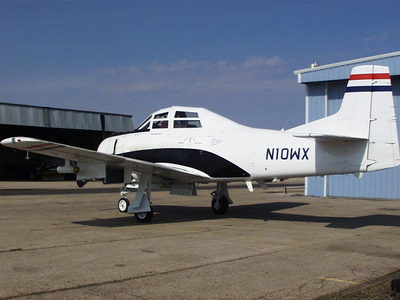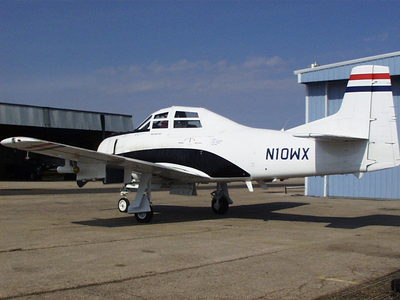Armored T-28 Research Aircraft Facility
Aircraft Description
 |
The T-28 was modified extensively from its original configuration. The leading edges of the wings and tail surfaces were covered with 2.29 mm (0.090 inch) 2024T4 heat-treated aluminum sheets formed to fit and bonded to the existing wing and tail surfaces. The tops of the wings were covered with 0.81 mm (0.032 inch) sheets of the same material. The leading edges of the cowling were covered with an additional sheet of fitted 3.18 mm (0.125 inch) aluminum. This armor plating adds about 318 kg (700 lb) to the aircraft weight.
The carburetor was protected from ingestion of large hailstones by the addition of a metal grate to the air intake to break up the hailstones entry. A similar device was installed over the oil cooler intake to prevent damage to the relatively fragile oil radiator.
The canopy also required substantial modification since the standard Plexiglas bubble canopy was much too weak to withstand encounters with large hail. The windshield was replaced with flat sheets of 1.91 cm (0.75 inch) stretched acrylic and the side panels were made of flat sections of 1.52 cm (0.60 inch) stretched acrylic. The windshield and the leading-edge armor were tested to withstand 7.6-cm diameter hail at penetration velocities by firing ice balls from a specially-built hail "cannon" at test sections of the aircraft.
The engine installed in 1972 required a new scheme for protecting it from hail damage since the cylinders and front of the engine were of a slightly different design than the engine originally installed on the aircraft. The push-rod housings and the ignition harness were protected with sections of electrical conduit formed to fit the respective areas. The propeller governor was protected with a shield of aluminum. The areas now most susceptible to damage on the entire aircraft were the baffles between the cylinders and the cooling fins on the cylinders themselves.
The T-28 was equipped with alcohol for anti-icing of the propeller and the carburetor to permit the engine to develop full power in icing conditions. Since the aircraft was somewhat overpowered, it was able to carry a substantial load of ice on the airframe if the engine developed full power.
The T-28 airframe was occasionally struck by lightning so lightning rods were placed on the aircraft extremities to attempt to reduce the lightning damage. The propeller was occasionally struck but usually sustained no physical damage other than small burned spots on its trailing edges. Significant burn marks on some of the airframe trailing edges resulted from lightning strikes in Oklahoma during SESAME '79 (Musil and Prodan, 1980). During subsequent field seasons, there were additional lightning strikes to the propeller and discharge pits on the trailing edges.
Since the distinct possibility existed that the entire electrical system could be disabled by a lightning strike or an unintentional overload, precautions were taken to minimize damage under such conditions. The aircraft has a 300 A 28 VDC generator used to power the sensing, recording, and de-icing equipment. To protect the system from damage due to equipment failures, double circuit breakers were placed on all high-power equipment and the switches were made easily accessible to the pilot. The pilot could thus turn off any or all scientific equipment in the event of an electrical problem. Since a primary flight attitude reference panel was not considered adequate for continued flight in the severe environment of a thunderstorm, the T-28 was equipped with dual artificial horizons, one electrical and the other vacuum driven, to enable continued safe flight in the event of a complete electrical failure.
The breathing oxygen system was completely overhauled and updated by the Naval Air Rework Facility during the extensive rework in 1972. This system provided safe, reliable operation to well above the T-28 service ceiling.
References
Musil, D. J., and J. Prodan, 1980: Direct effects of lightning on an aircraft during intentional penetrations of thunderstorms. Proc. at Symposium on Lightning Technology, NASA Langley Research Center, Hampton, VA, 363-370.
